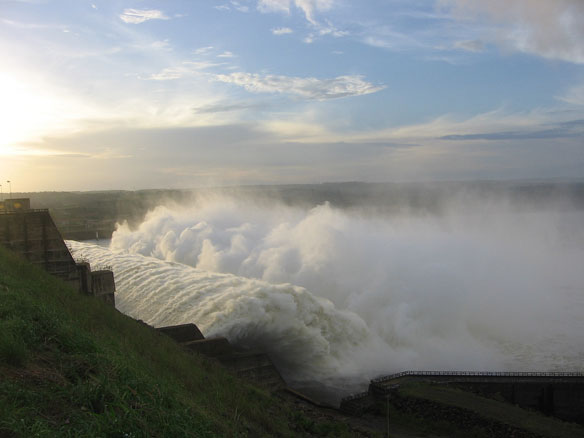
The new database shows information for the world’s 50 major river basins.
On August 26th, International Rivers launched “The State of the World’s Rivers,” a first-of-its-kind interactive online database that illustrates the role that dams have played in impoverishing the health of the world’s river basins. The database shows how river fragmentation due to decades of dam-building is highly correlated with poor water quality and low biodiversity. Many of the world’s great river basins have been dammed to the point of serious decline, including the Mississippi, Yangtze, Paraná and Danube.
“The evidence we’ve compiled of planetary-scale impacts from river change is strong enough to warrant a major international focus on understanding the thresholds for ‘river change’ in the world’s major basins, and for the planet as a whole system,” said Jason Rainey, Executive Director of International Rivers.
For example, in the Middle East, decades of dam building in the Tigris-Euphrates basin have made it one of the most fragmented basins in the world. As a result, the basin’s flooded grassland marshes have significantly decreased, leading to the disappearance of salt-tolerant vegetation that helped protect coastal areas, and a reduction in the plankton-rich waters that fertilize surrounding soils. Habitat has decreased for 52 native fish species, migratory bird species, and mammals such as the water buffalo, antelopes and gazelles, and the jerboa.
Meanwhile, some of the lesser-dammed basins, which are still relatively healthy at this point, are being targeted for major damming. For example, the most biodiverse basin in the world, the Amazon, still provides habitat for roughly 14,000 species of mammals, 2,200 fish species, 1,500 bird species, and more than 1,000 amphibian species, like the Amazon River Dolphin, the Amazonian Manatee, and the Giant Otter.
When all dam sizes are counted, an astonishing 412 dams are planned or under construction in the Paraná basin, and 254 in the Amazon basin.

Tucuruí Dam spillway, Tocantins River, Brazil (Eneida Castro). Brazilian researchers estimated in 2007 that methane from dams is responsible for around 4% of human-caused global warming. Greenhouse gases, primarily methane (CH4) and carbon dioxide (CO2), are emitted from the surface of the reservoir, at turbines and spillways, and for tens of kilometers downstream. Emissions are highest in hot climates. Captions and Photo source: ©© International Rivers
In Asia, China plans to continue to dam the Yangtze basin with at least another 94 planned large dams, while an additional 73 are under construction. At least 153 more dams are planned or already being built in the Mekong basin.
Other basins that are high in biodiversity and water quality which are also targets for dam-building include the Tocantins, the Irrawaddy, the Congo, and the Zambezi.
Zachary Hurwitz, the coordinator of the project, said: “Basins that have been highly fragmented by dams provide important lessons for managing the relatively un-dammed basins that remain. Governments should turn their attention to river preservation to protect these basins’ valuable ecosystem services.”
In addition to calling for an inter-governmental panel of experts to assess the State of the World’s Rivers, International Rivers recommends that no more dams be built on the mainstems of rivers, and that damming rivers becomes an option of last resort.
Created using Google Earth, the State of the World’s Rivers website maps nearly 6,000 dams in the world’s 50 major river basins, and ranks their ecological health according to indicators of river fragmentation, water quality and biodiversity. The dams mapped are a small percentage of the more than 50,000 large dams that clog the arteries of our planet.
Users of the site can compare how each individual basin ranks in fragmentation, biodiversity, and water quality, and explore ten of the most significant river basins in more depth. Each focus basin describes the threats from dam building, and allows users to see how dams can impact Ramsar Sites of Wetlands of International Importance and UNESCO World Heritage Sites.
Original Article And Learn More, International Rivers
Sediment Trapped Behind Dams Makes Them ‘Hot Spots’ for Greenhouse Gas Emissions
The large reservoirs of water behind the world’s 50,000 large dams are a known source of methane. Methane has a warming effect 25 times more powerful than carbon dioxide. That knowledge led to questions about hydroelectric power’s image as a green and nonpolluting energy source…
New Global Warming Culprit: Dams
Washington State University researchers have documented an underappreciated suite of players in global warming: dams, the water reservoirs behind them, and surges of greenhouse gases as water levels go up and down…
Large Dams “Highly Correlated” with Poor Water Quality, IPS news
Dams As Weapons Of War, Yale E360
DamNation; a Documentary That’s Testing the Waters of Corporate Social Responsibility; From Felt Soul Media
DamNation is a feature documentary, shown this week at SXSW in Austin, Tx. DamNation’s majestic cinematography and unexpected discoveries move through rivers and landscapes altered by dams, but also through a metamorphosis in values, from conquest of the natural world to knowing ourselves as part of nature…

People of Amazon… Photo source: ©© Neil Palmer/CIAT/CIFOR.
A series of dams are being planned for the Tapajós River, also a major Amazon tributary. The dams would flood national parks, reserves and indigenous lands. Captions: ©© International Rivers.








